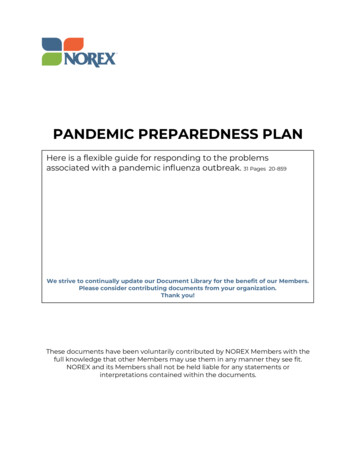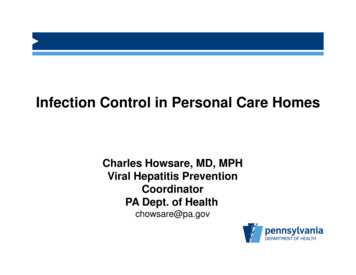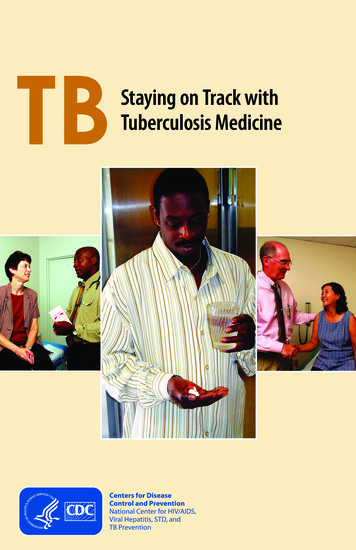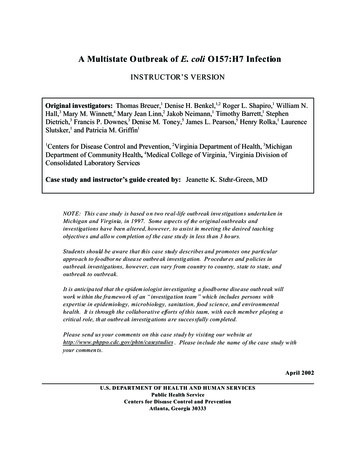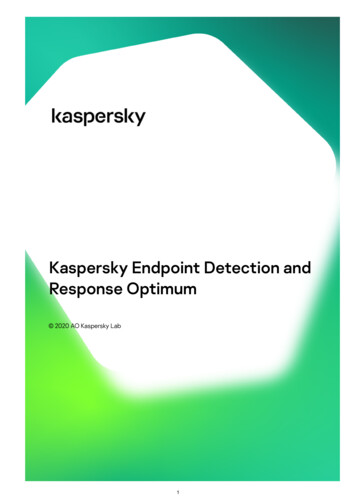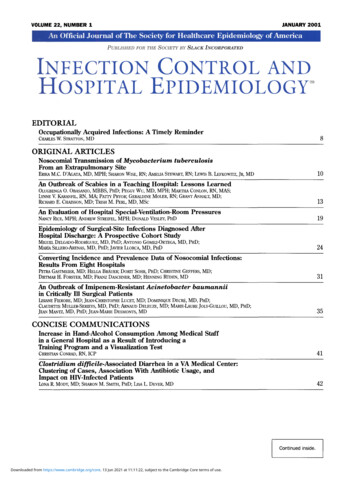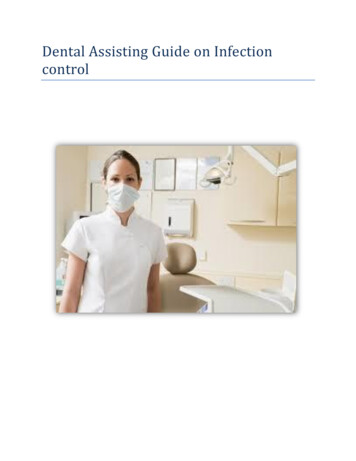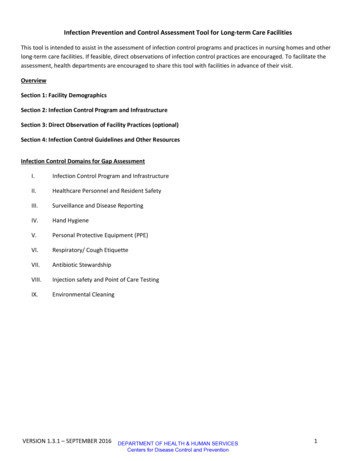
Transcription
Infection Prevention and Control Assessment Tool for Long-term Care FacilitiesThis tool is intended to assist in the assessment of infection control programs and practices in nursing homes and otherlong-term care facilities. If feasible, direct observations of infection control practices are encouraged. To facilitate theassessment, health departments are encouraged to share this tool with facilities in advance of their visit.OverviewSection 1: Facility DemographicsSection 2: Infection Control Program and InfrastructureSection 3: Direct Observation of Facility Practices (optional)Section 4: Infection Control Guidelines and Other ResourcesInfection Control Domains for Gap AssessmentI.Infection Control Program and InfrastructureII.Healthcare Personnel and Resident SafetyIII.Surveillance and Disease ReportingIV.Hand HygieneV.Personal Protective Equipment (PPE)VI.Respiratory/ Cough EtiquetteVII.Antibiotic StewardshipVIII.Injection safety and Point of Care TestingIX.Environmental CleaningVERSION 1.3.1 – SEPTEMBER 2016 DEPARTMENT OF HEALTH & HUMAN SERVICESCenters for Disease Control and Prevention1
Section 1. Facility DemographicsV1-3-1Facility Name (for healthdepartment use only)Click here to enter text.NHSN Facility OrganizationID (for health departmentuse only)State-assigned Unique IDDate of AssessmentType of AssessmentClick here to enter text.Rationale for Assessment(Select all that apply) Outbreak Input from accrediting organization or state survey agency NHSN data (if available) Collaborative (specify partner[s]): Click here to enter text.) Other (specify): Click here to enter text.Is the facility licensed bythe state?Is the facility certified bythe Centers for Medicare& Medicaid Services (CMS)Facility type Yes No Yes NoNumber of licensed bedsTotal staff hours per weekdedicated to infectionprevention and controlactivitiesIs the facility affiliated witha hospital?Click here to enter text.Click here to enter a date. On-site Other (specify): Click here to enter text. Nursing home Intermediate care facility Assisted living facility Other (specify): Click here to enter text.Click here to enter text.Click here to enter text. Yes (specify – for health department use only): Click here to enter text. NoVERSION 1.3.1 – SEPTEMBER 2016 DEPARTMENT OF HEALTH & HUMAN SERVICESCenters for Disease Control and Prevention2
Section 2: Infection Control Program and InfrastructureI.Infection Control Program and InfrastructureElements to be assessedAssessmentA. The facility has specified a person (e.g., staff, consultant) who isresponsible for coordinating the IC program. Yes NoB.The person responsible for coordinating the infectionprevention program has received training in ICExamples of training may include: Successful completion ofinitial and/or recertification exams developed by theCertification Board for Infection Control & Epidemiology;Participation in infection control courses organized by the stateor recognized professional societies (e.g., APIC, SHEA).C.The facility has a process for reviewing infection surveillancedata and infection prevention activities (e.g., presentation at QAcommittee).E.F.II.Click here to enter text.Click here to enter text. Yes No Yes NoD. Written infection control policies and procedures are availableand based on evidence-based guidelines (e.g., CDC/HICPAC),regulations (F-441), or standards.Note: Policies and procedures should be tailored to the facility andextend beyond OSHA bloodborne pathogen training or the CMSState Operations ManualNotes/Areas for ImprovementClick here to enter text.Click here to enter text. Yes NoWritten infection control policies and procedures are reviewedat least annually or according to state or federal requirements,and updated if appropriate. Yes NoThe facility has a written plan for emergency preparedness (e.g.,pandemic influenza or natural disaster). Yes NoClick here to enter text.Click here to enter text.Healthcare Personnel and Resident SafetyElements to be assessedAssessmentNotes/Areas for ImprovementHealthcare PersonnelA. The facility has work-exclusion policies concerning avoidingcontact with residents when personnel have potentiallytransmissible conditions which do not penalize with loss ofwages, benefits, or job status.B. The facility educates personnel on prompt reporting ofsigns/symptoms of a potentially transmissible illness to asupervisorC. The facility conducts baseline Tuberculosis (TB) screening for allnew personnelClick here to enter text. Yes No Yes No Yes NoVERSION 1.3.1 – SEPTEMBER 2016 DEPARTMENT OF HEALTH & HUMAN SERVICESCenters for Disease Control and PreventionClick here to enter text.Click here to enter text.3
II.Healthcare Personnel and Resident Safety, continuedElements to be assessedD. The facility has a policy to assess healthcare personnel risk forTB (based on regional, community data) and requires periodic(at least annual) TB screening if indicated.Assessment Yes NoNotes/Areas for ImprovementClick here to enter text.E.The facility offers Hepatitis B vaccination to all personnel whomay be exposed to blood or body fluids as part of their jobduties Yes NoF.The facility offers all personnel influenza vaccination annually. Yes NoClick here to enter text. Yes NoClick here to enter text.G. The facility maintains written records of personnel influenzavaccination from the most recent influenza season.H. The facility has an exposure control plan which addressespotential hazards posed by specific services provided by thefacility (e.g., blood-borne pathogens).Note: A model template, which includes a guide for creating anexposure control plan that meets the requirements of the OSHABloodborne Pathogens Standard is available .J.Click here to enter text. Yes NoAll personnel receive training and competency validation onmanaging a blood-borne pathogen exposure at the time ofemployment.Note: An exposure incident refers to a specific eye, mouth, othermucous membrane, non-intact skin, or parenteral contact withblood or other potentially infectious materials that results fromthe performance of an individual’s duties.All personnel received training and competency validation onmanaging a potential blood-borne pathogen exposure withinthe past 12 months.Click here to enter text.Click here to enter text. Yes No Yes NoClick here to enter text.Resident SafetyA. The facility currently has a written policy for to assess risk for TB(based on regional, community data) and provide screening toresidents on admission. Yes NoB.The facility documents resident immunization status forpneumococcal vaccination at time of admission. Yes NoClick here to enter text.C.The facility offers annual influenza vaccination to residents. Yes NoClick here to enter text.VERSION 1.3.1 – SEPTEMBER 2016 DEPARTMENT OF HEALTH & HUMAN SERVICESCenters for Disease Control and PreventionClick here to enter text.4
III.Surveillance and Disease ReportingElements to be assessedAssessmentNotes/Areas for ImprovementSurveillanceA. The facility has written intake procedures to identify potentiallyinfectious persons at the time of admission.Examples: Documenting recent antibiotic use, and history ofinfections or colonization with C. difficile or antibiotic-resistantorganismsB.C.The facility has system for notification of infection preventioncoordinator when antibiotic-resistant organisms or C. difficileare reported by clinical laboratory.The facility has a written surveillance plan outlining the activitiesfor monitoring/tracking infections occurring in residents of thefacility.D. The facility has system to follow-up on clinical information, (e.g.,laboratory, procedure results and diagnoses), when residentsare transferred to acute care hospitals for management ofsuspected infections, including sepsis.Click here to enter text. Yes No Yes No Yes NoClick here to enter text.Click here to enter text.Click here to enter text. Yes NoNote: Receiving discharge records at the time of re-admission is notsufficient to answer “yes”Disease ReportingA. The facility has a written plan for outbreak response whichincludes a definition, procedures for surveillance andcontainment, and a list of syndromes or pathogens for whichmonitoring is performed. Yes NoB.The facility has a current list of diseases reportable to publichealth authorities. Yes NoClick here to enter text.C.The facility can provide point(s) of contact at the local or statehealth department for assistance with outbreak response. Yes NoClick here to enter text.IV.Click here to enter text.Hand HygieneElements to be assessedA. Hand hygiene policies promote preferential use of alcoholbased hand rub (ABHR) over soap and water in most clinicalsituations.Note: Soap and water should be used when hands are visiblysoiled (e.g., blood, body fluids) and is also preferred after caringfor a patient with known or suspected C. difficile or norovirusduring an outbreak or if rates of C. difficile infection in thefacility are persistently high.AssessmentNotes/Areas for ImprovementClick here to enter text. Yes NoVERSION 1.3.1 – SEPTEMBER 2016 DEPARTMENT OF HEALTH & HUMAN SERVICESCenters for Disease Control and Prevention5
IV.Hand Hygiene, continuedElements to be assessedAssessmentB.All personnel receive training and competency validation on HHat the time of employment. Yes NoClick here to enter text.C.All personnel received training and competency validation onHH within the past 12 months. Yes NoClick here to enter text.D. The facility routinely audits (monitors and documents)adherence to HHNote: If yes, facility should describe auditing process and providedocumentation of auditsThe facility provides feedback to personnel regarding their HHperformance.Note: If yes, facility should describe feedback process and providedocumentation of feedback reportsClick here to enter text. Yes NoE.F.V.Supplies necessary for adherence to HH (e.g., soap, water, papertowels, alcohol-based hand rub) are readily accessible inresident care areas (i.e., nursing units, resident rooms, therapyrooms).C.Click here to enter text. Yes NoClick here to enter text. Yes NoPersonal Protective Equipment (PPE)Elements to be assessedA. The facility has a policy on Standard Precautions which includesselection and use of PPE (e.g., indications, donning/doffingprocedures).B.Notes/Areas for ImprovementThe facility has a policy on Transmission-based Precautions thatincludes the clinical conditions for which specific PPE should beused (e.g., C. difficile, Influenza).Appropriate personnel receive job-specific training andcompetency validation on proper use of PPE at the time ofemployment.D. Appropriate personnel received job-specific training andcompetency validation on proper use of PPE within the past 12months.The facility routinely audits (monitors and documents)adherence to PPE use (e.g., adherence when indicated,donning/doffing).Note: If yes, facility should describe auditing process and providedocumentation of auditsAssessment Yes No Yes No Yes No Yes NoE.The facility provides feedback to personnel regarding their PPEuse.Note: If yes, facility should describe feedback process and providedocumentation of feedback reportsClick here to enter text.Click here to enter text.Click here to enter text.Click here to enter text.Click here to enter text. Yes NoF.G. Supplies necessary for adherence to proper PPE use (e.g.,gloves, gowns, masks) are readily accessible in resident careareas (i.e., nursing units, therapy rooms).Notes/Areas for ImprovementClick here to enter text. Yes No Yes NoVERSION 1.3.1 – SEPTEMBER 2016 DEPARTMENT OF HEALTH & HUMAN SERVICESCenters for Disease Control and PreventionClick here to enter text.6
VI.Respiratory Hygiene/Cough EtiquetteElements to be assessedA. The facility has signs posted at entrances with instructions toindividuals with symptoms of respiratory infection to: covertheir mouth/nose when coughing or sneezing, use and disposeof tissues, and perform hand hygiene after contact withrespiratory secretions?B. The facility provides resources for performing hand hygiene nearthe entrance and in common areas.C. The facility offers facemasks to coughing residents and othersymptomatic persons upon entry to the facility.D. The facility educates family and visitors to notify staff and takeappropriate precautions if they are having symptoms ofrespiratory infection during their visit?E. All personnel receive education on the importance of infectionprevention measures to contain respiratory secretions toprevent the spread of respiratory pathogensVII.AssessmentNotes/Areas for ImprovementClick here to enter text. Yes No Yes NoClick here to enter text. Yes NoClick here to enter text. Yes No Yes NoClick here to enter text.Click here to enter text.Antibiotic StewardshipElements to be assessedA. The facility can demonstrate leadership support for efforts toimprove antibiotic use (antibiotic stewardship).B. The facility has identified individuals accountable for leadingantibiotic stewardship activitiesAssessmentNotes/Areas for Improvement Yes NoClick here to enter text. Yes NoClick here to enter text.The facility has access to individuals with antibiotic prescribingexpertise (e.g. ID trained physician or pharmacist).D. The facility has written policies on antibiotic prescribing. Yes NoClick here to enter text. Yes NoClick here to enter text.E. Yes NoClick here to enter text.C.F.The facility has implemented practices in place to improveantibiotic use.The facility has a report summarizing antibiotic use frompharmacy data created within last 6 months.Note: Report could include number of new starts, types of drugsprescribed, number of days of antibiotic treatment) from thepharmacy on a regular basisG. The facility has a report summarizing antibiotic resistance (i.e.,antibiogram) from the laboratory created within the past 24months.H. The facility provides clinical prescribers with feedback abouttheir antibiotic prescribing practices.Click here to enter text. Yes No Yes NoClick here to enter text.Click here to enter text. Yes NoNote: If yes, facility should provide documentation of feedbackreportsVERSION 1.3.1 – SEPTEMBER 2016 DEPARTMENT OF HEALTH & HUMAN SERVICESCenters for Disease Control and Prevention7
VII.I.J.VIII.Antibiotic Stewardship, continuedElements to be assessedThe facility has provided training on antibiotic use (stewardship)to all nursing staff within the last 12 months.The facility has provided training on antibiotic use (stewardship)to all clinical providers with prescribing privileges within the last12 months.Assessment Yes No Yes NoNotes/Areas for ImprovementClick here to enter text.Click here to enter text.Injection Safety and Point of Care TestingElements to be assessedA. The facility has a policy on injection safety which includesprotocols for performing finger sticks and point of care testing(e.g., assisted blood glucose monitoring, or AMBG).B. Personnel who perform point of care testing (e.g., AMBG)receive training and competency validation on injection safetyprocedures at time of employment.Assessment Yes NoNotes/Areas for ImprovementClick here to enter text.Click here to enter text. Yes NoNote: If point of care tests are performed by contract personnel,facility should verify that training is provided by contractingcompanyC.Personnel who perform point of care testing (e.g., AMBG)receive training and competency validation on injection safetyprocedures within the past 12 months.Click here to enter text. Yes NoNote: If point of care tests are performed by contract personnel,facility should verify that training is provided by contractingcompanyD. The facility routinely audits (monitors and documents)adherence to injection safety procedures during point of caretesting (e.g., AMBG).Click here to enter text. Yes NoNote: If yes, facility should describe auditing process and providedocumentation of auditsE.The facility provides feedback to personnel regarding theiradherence to injection safety procedures during point of caretesting (e.g., AMBG).Click here to enter text. Yes NoNote: If yes, facility should describe feedback process and providedocumentation of feedback reportsF.Supplies necessary for adherence to safe injection practices(e.g., single-use, auto-disabling lancets, sharps containers) arereadily accessible in resident care areas (i.e., nursing units).G. The facility has policies and procedures to track personnelaccess to controlled substances to prevent narcotics theft/drugdiversion. Yes No Yes NoVERSION 1.3.1 – SEPTEMBER 2016 DEPARTMENT OF HEALTH & HUMAN SERVICESCenters for Disease Control and PreventionClick here to enter text.Click here to enter text.8
IX.Environmental CleaningElements to be assessedA. The facility has written cleaning/disinfection policies whichinclude routine and terminal cleaning and disinfection ofresident rooms.B. The facility has written cleaning/disinfection policies whichinclude routine and terminal cleaning and disinfection of roomsof residents on contact precautions (e.g., C. difficile).C.The facility has written cleaning/disinfection policies whichinclude cleaning and disinfection of high-touch surfaces incommon areas.D. The facility cleaning/disinfection policies include handling ofequipment shared among residents (e.g., blood pressure cuffs,rehab therapy equipment, etc.).E. Facility has policies and procedures to ensure that reusablemedical devices (e.g., blood glucose meters, wound careequipment, podiatry equipment, and dental equipment) arecleaned and reprocessed appropriately prior to use on anotherpatient.Assessment Yes No Yes No Yes No Yes No Yes No Not ApplicableNotes/Areas for ImprovementClick here to enter text.Click here to enter text.Click here to enter text.Click here to enter text.Click here to enter text.Note: If external consultants (e.g., wound care nurses, dentists orpodiatrists) provide services in the facility, the facility must verifythese providers have adequate supplies and space to followappropriate cleaning/disinfection (reprocessing) procedures toprevent transmission of infectious agentsNote: Select not applicable for the following:1. All medical devices are single use only or dedicated toindividual residents2. No procedures involving medical devices are performed inthe facility by staff or external consultants3. External consultants providing services which involvemedical devices have adequate supplies that no devices areshared on-site and all reprocessing is performed off-siteF. Appropriate personnel receive job-specific training andcompetency validation on cleaning and disinfection proceduresat the time of employment.Click here to enter text. Yes NoNote: If environmental services are performed by contractpersonnel, facility should verify that training is provided bycontracting companyVERSION 1.3.1 – SEPTEMBER 2016 DEPARTMENT OF HEALTH & HUMAN SERVICESCenters for Disease Control and Prevention9
IX.Environmental Cleaning, continuedElements to be assessedG. Appropriate personnel received job-specific training andcompetency validation on cleaning and disinfection procedureswithin the past 12 months.AssessmentNotes/Areas for ImprovementClick here to enter text. Yes NoNote: If environmental services are performed by contractpersonnel, facility should verify that training is provided bycontracting companyH. The facility routinely audits (monitors and documents) quality ofcleaning and disinfection procedures.Click here to enter text. Yes NoNote: If yes, facility should describe auditing process and providedocumentation of auditsI.The facility provides feedback to personnel regarding the qualityof cleaning and disinfection procedures.Click here to enter text. Yes NoNote: If yes, facility should describe feedback process and providedocumentation of feedback reportsJ.Supplies necessary for appropriate cleaning and disinfectionprocedures (e.g., EPA-registered, including products labeled aseffective against C. difficile and Norovirus) are available.Click here to enter text. Yes NoNote: If environmental services are performed by contractpersonnel, facility should verify that appropriate EPA-registeredproducts are provided by contracting companySection 3: Direct Observation of Facility Practices (optional)Certain infection control lapses (e.g., reuse of syringes on more than one patient or to access a medication containerthat is used for subsequent patients; reuse of lancets) can result in bloodborne pathogen transmission and should behalted immediately. Identification of such lapses warrants appropriate notification and testing of potentially affectedpatients.VERSION 1.3.1 – SEPTEMBER 2016 DEPARTMENT OF HEALTH & HUMAN SERVICESCenters for Disease Control and Prevention10
Point of Care Testing Observations (e.g., assisted blood glucose monitoring)HH performed Yes NoClean gloves worn Yes NoSingle use, lancetused?1Testing meter2to resident, Yes No Dedicatedcleaned/disinfectedGloves removed3HH performed3 Yes No Yes Nobefore storing Cleaned/disinfectedbefore next resident Yes No Yes Noto resident, Yes No Dedicatedcleaned/disinfected Yes No Yes Nobefore storing Cleaned/disinfectedbefore next resident Yes No Yes Noto resident, Yes No Dedicatedcleaned/disinfected Yes No Yes Nobefore storing Cleaned/disinfectedbefore next resident Yes No Yes Noto resident, Yes No Dedicatedcleaned/disinfected Yes No Yes Nobefore storing Cleaned/disinfectedbefore next resident Yes No Yes Noto resident, Yes No Dedicatedcleaned/disinfected Yes No Yes Nobefore storing Cleaned/disinfectedbefore next resident Yes No Yes Noto resident, Yes No Dedicatedcleaned/disinfected Yes No Yes Nobefore storing Cleaned/disinfectedbefore next resident Yes No Yes Noto resident, Yes No Dedicatedcleaned/disinfected Yes No Yes Nobefore storing Cleaned/disinfectedbefore next resident Yes No Yes Noto resident, Yes No Dedicatedcleaned/disinfected Yes No Yes Nobefore storing Cleaned/disinfectedbefore next residentNotes: 1Lancet holder devices (e.g., lancing penlets) are not suitable for multi-patient use.2If the manufacturer does not provide instructions for cleaning and disinfection, then the testing meter should not be used for 1patient.3Gloves should be changed and HH performed before assisting the next resident with POCT.VERSION 1.3.1 – SEPTEMBER 2016 DEPARTMENT OF HEALTH & HUMAN SERVICESCenters for Disease Control and Prevention11
Hand Hygiene and Contact Precautions ObservationsStaff type*Type of opportunityClick here toenter text. Click here toenter text.Click here toenter text.Click here toenter text.Click here toenter text.Click here toenter text.Click here toenter text.Click here toenter text.Click here toenter text.HH performed?Room entry Room exitBefore resident contactAfter resident contactBefore glove After gloveOther: Click here to enter text. Room entry Room exitBefore resident contactAfter resident contactBefore glove After gloveOther: Click here to enter text. Room entry Room exitBefore resident contactAfter resident contactBefore glove After gloveOther: Click here to enter text. Room entry Room exitBefore resident contactAfter resident contactBefore glove After gloveOther: Click here to enter text. Room entry Room exitBefore resident contactAfter resident contactBefore glove After gloveOther: Click here to enter text. Room entry Room exitBefore resident contactAfter resident contactBefore glove After gloveOther: Click here to enter text. Room entry Room exitBefore resident contactAfter resident contactBefore glove After gloveOther: Click here to enter text. Room entry Room exitBefore resident contactAfter resident contactBefore glove After gloveOther: Click here to enter text. Room entry Room exitBefore resident contactAfter resident contactBefore glove After gloveOther: Click here to enter text. Alcohol-rubHand WashNo HH doneAlcohol-rubHand WashNo HH doneAlcohol-rubHand WashNo HH doneAlcohol-rubHand WashNo HH doneAlcohol-rubHand WashNo HH doneAlcohol-rubHand WashNo HH doneAlcohol-rubHand WashNo HH doneAlcohol-rubHand WashNo HH doneAlcohol-rubHand WashNo HH doneGown or glove indicated?Gown/glove used? Gown onlyGlove onlyBothNoGown onlyGlove onlyBothNoGown onlyGlove onlyBothNoGown onlyGlove onlyBothNoGown onlyGlove onlyBothNoGown onlyGlove onlyBothNoGown onlyGlove onlyBothNoGown onlyGlove onlyBothNoGown onlyGlove onlyBothNoGown usedGlove usedBothNeitherGown usedGlove usedBothNeitherGown usedGlove usedBothNeitherGown usedGlove usedBothNeitherGown usedGlove usedBothNeitherGown usedGlove usedBothNeitherGown usedGlove usedBothNeitherGown usedGlove usedBothNeitherGown usedGlove usedBothNeither*Staff key: MD Physician, PA Physician assist., NP Advanced practice nurse, RN Registered nurse, LPN Licensed practice nurse, CNA Certified nurse aide orassist., REHAB Rehabilitation staff (e.g. physical, occupational, speech), DIET Dietary staff, EVS Environmental services or housekeeping staff, SW Social worker,UNK Unknown/unable to determineVERSION 1.3.1 – SEPTEMBER 2016 DEPARTMENT OF HEALTH & HUMAN SERVICESCenters for Disease Control and Prevention12
Indwelling Urinary Catheter (IUC) Maintenance Observations (i.e., Foley)Indicationassessedregularly 1 ionappropriate 2 YesNoNAYesNoNAYesNoNAYesNoNAYesNoNAYesNoNAHH beforehandlingIUC YesNoNAYesNoNAYesNoNAYesNoNAYesNoNAYesNoNAClean glovesdonned beforehandling IUCBag 2/3full esNoNAYesNoNAYesNoNAYesNoNAYesNoNABag belowbladder ctedflow curedproperly edproperly 3 collectedproperly 4 movedafter handlingIUC Yes No NA Yes No NA Yes No NA Yes No NA Yes No NA Yes No NAHH afterhandlingIUC YesNoNAYesNoNAYesNoNAYesNoNAYesNoNAYesNoNA*NA Not assessed1 On-going need for IUC is assessed for appropriateness and indication is documented in medical records per facility policy2 See: e2009final.pdf Table 2A for list of appropriate indications for IUC and more information regarding appropriate maintenance3 Clean container is used to catch urine and spigot does not come into contact with container; Additional PPE (e.g., face shields, gown) should be worn per facility policy to prevent body fluidexposure4 HH is performed and clean gloves worn to manipulate IUC sample collection port, port is cleaned with alcohol prior to access, specimen is collected using blunt syringe, leur lock syringe, or 10 ccsyringe; specimen not obtained from the collection bagComments: Click here to enter text.VERSION 1.3.1 – SEPTEMBER 2016DEPARTMENT OF HEALTH & HUMAN SERVICESCenters for Disease Control and Prevention13
Central Venous Catheter (CVC) Maintenance ObservationsNOTE: May be referred to as Central Line and includes PICC lineIndicationappropriate 1 YesNoNA*YesNoNAYesNoNAYesNoNAYesNoNACVCCVCHHClean glovesDressingconnectedCVC hub Unused CVC CVC accessedmaintenanceDressing performeddonnedCVC hubclean, dryandallowedtoports arewith sterileperformeddated 3beforebeforescrubbed y 2handling CVC handling CVCaseptically Yes Yes Yes Yes Yes Yes Yes Yes Yes Yes No No No No No No No No No No NA NA NA NA NA NA NA NA NA NA Yes Yes Yes Yes Yes Yes Yes Yes Yes Yes No No No No No No No No No No NA NA NA NA NA NA NA NA NA NA Yes Yes Yes Yes Yes Yes Yes Yes Yes Yes No No No No No No No No No No NA NA NA NA NA NA NA NA NA NA Yes Yes Yes Yes Yes Yes Yes Yes Yes Yes No No No No No No No No No No NA NA NA NA NA NA NA NA NA NA Yes Yes Yes Yes Yes Yes Yes Yes Yes Yes No No No No No No No No No No NA NA NA NA NA NA NA NA NA NAGlovesremovedafterhandlingCVC Yes No NA Yes No NA Yes No NA Yes No NA Yes No NAHH afterhandlingCVC YesNoNAYesNoNAYesNoNAYesNoNAYesNoNA*NA Not assessed1 Refer to lines-2011.pdf for recommendations on CVC maintenance (e.g., appropriate indications)2 Appropriate maintenance should include documentation of the following in the medical record: date and site of insertion, assessment of on-going need for CVC, and frequency of dressing changesand replacement of system components (e.g., catheter tubing, connectors) per facility policy3 Dressing should be labeled with date changed and be within timeframe for routine dressing changes per facility policy4 Procedure for “Scrub the Hub”: Hub is handled aseptically (i.e., ensuring hub does not touch anything non-sterile) while port cap is removed and discarded; Appropriate antiseptic pad (e.g., 70%alcohol, chlorohexidine) is used to scrub end and sides (threads) of hub thoroughly applying friction for 10 to 15 seconds; Catheter line is disinfected several centimeters toward resident’s body usingsame antiseptic pad to apply friction; Hub is left open “uncapped” shortest time possible. See http://www.cd
regulations (F-441), or standards. Note: Policies and procedures should be tailored to the facility and extend beyond OSHA bloodborne pathogen training or the CMS State Operations Manual Yes No Click here to enter text. E. Writt

